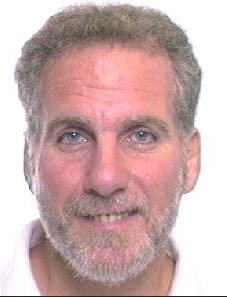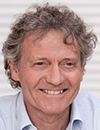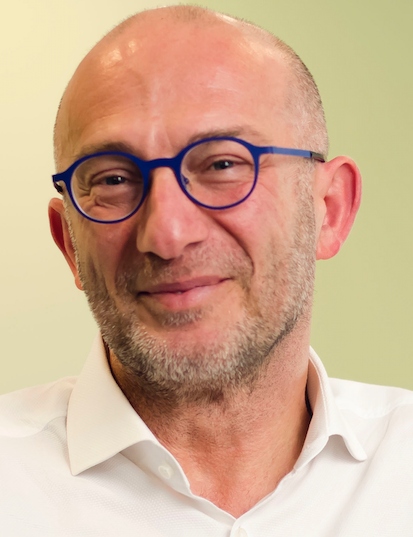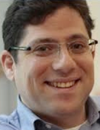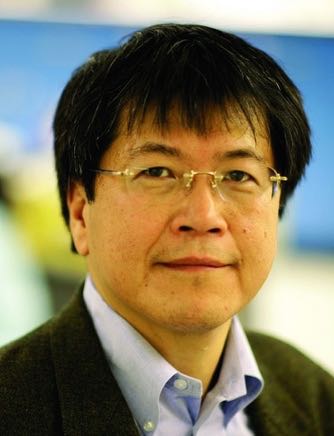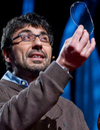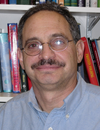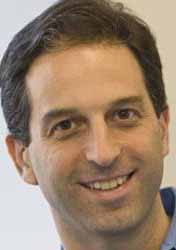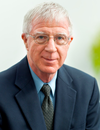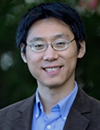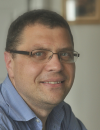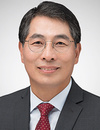07:00 | Morning Coffee, Breakfast Pastries and Networking in the Exhibit Hall |
|
Session Title: Biofabrication Approaches and Applications |
| |
07:30 | 3-D Bio-Printed Glioblastoma-Vascular Niche
Guohao Dai, Associate Professor, Department of Bioengineering, Northeastern University, United States of America
In this talk, I will present the development of a 3-D bioprinting system to create functional perfused vasculature in thick tissue, and its application to construct a model to study glioblastoma vascular invasion.
|
08:00 |  | Keynote Presentation Strategies for Bioprinting of Macroscopic Tissue Constructs
Michael Gelinsky, Professor and Head, Center for Translational Bone, Joint and Soft Tissue Research, Faculty of Medicine, Technische Universität Dresden, Germany
Bioprinting has developed very fast in the last couple of years and several additive manufacturing technologies as well as biomaterials, suitable for fabrication of cell containing constructs are available today. But one major problem still limits manufacturing of mechanically stable and macroscopic tissue equivalents: bioprinting with live cells requires soft and low concentrated hydrogels (‘bioinks’) whereas for construction purposes stiff, high concentrated and/or highly crosslinked materials are needed. Several and very different strategies have been proposed to overcome this problem, e. g. combining highly viscous cell-free materials like PCL as mechanically stable framework with less viscous, cell-laden hydrogels; increasing the viscosity of bioinks by blending with other (bio)polymers or short fibers – or stabilizing the constructs during fabrication with inert supportive materials. The lecture will give an overview about some of the current developments and novel strategies for bioprinting of macroscopic tissue constructs. |
|
08:30 | Novel Composite Bioinks For 3D Bioprinting
Wojciech Swieszkowski, Professor in Materials Design Division, Faculty of Materials Science and Engineering, Warsaw University of Technology, Poland
3D bioprinting is a fast-emerging technique in tissue engineering which allows for the controlled and simultaneous 3D deposition of living cells and supporting biomaterials. This technique combines the features of 3D printing of the patient-specific scaffolds with the possibility of precisely depositing living cells in the 3D space. Many synthetic and natural polymeric inks have been applied in bioprinting. The goal is to develop ink which possesses properties of native extracellular matrix. Inspiration from the reinforcing fibres occurring in articular cartilage or ceramic particles in bone tissue prompted us to use these reinforcements to enhance stability and mechanical properties of the hydrogel based bioink. The objective of this work was to show the reinforcing effect of short sub-micron fibres (SF) or micro-particles in 3D printed cells-hydrogel constructs. The biodegradable polymeric SF and TCP ceramic particles were embedded in alginate/gelatin hydrogels matrix and printed with different types of cells. Preliminary results revealed a beneficial influence of additional reinforcements on stability and mechanical properties of the tissue engineered hybrid construct and cell growth in vitro. |
09:00 | 3D Multimodal Bioprinter Capable of Multiscale Deposition to Deal with Tissue Complexity
Fabien Guillemot, CEO, Poietis, France
Dealing with tissue complexity and reproducing the functional anisotropy of human tissues remain a puzzling challenge for tissue engineers. Emergence of the biological functions results from dynamic interactions between cells, and with extracellular matrix. Experimental data showing that cell fate (migration, polarization, proliferation…) is triggered by biochemical and/or mechanical cues arising from cell micro-environment suggests that tissue formation obeys to short range orders without reference to a macroscopic or global pattern. In that context, the winning tissue engineering strategy might rely on guiding tissue morphogenesis from the cell to the tissue level. From a technological point of view, the Laser-Assisted Bioprinting (LAB) technology has emerged as an alternative method to inkjet and bioextrusion methods, thereby overcoming some of their limitations (namely clogging of print heads or capillaries) to pattern living cells and biomaterials with a micron-scale resolution and high cell viability. LAB applications has been limited so far to biofabrication of thin constructs. In this work, we present an original 3D multimodal and modular bioprinter which combines LAB with microvalve bioprinting. Thanks to this system, cells can be printed at cell resolution using LAB while biomaterials are printed with a coarser resolution (100 µm) using microvalve bioprinting. Interestingly, we show that 1 mm thick 3D constructs can be printed with different biomaterial layer thicknesses (eg made of collagen, agarose) and with multiple cell micropatterns across tissue constructs. In conclusion, combining technologies featured by different resolution opens new horizons for controlling micro and macro organization of tissue components, and hence for guiding cellular morphogenesis within thick 3D tissues. |
09:30 |  | Keynote Presentation Microfabricated Systems to Study Cancer Metastasis
Joyce Wong, Professor of Biomedical Engineering and Materials Science & Engineering, Boston University, United States of America
In this talk, I will describe our recent work in which we have developed
simple microfabricated systems in which cancer cells interact with
niche cells and other models of microenvironments that can be easily
microfabricated. More complex systems can be developed to look at
isolated steps in the metastasis process. Finally, I will describe our
work that integrates simple tissues on a chip with optimization of drug
delivery carriers and imaging contrast agents. |
|
10:00 |  Technology Spotlight: Technology Spotlight:
BioSafety in the Age of BioManufacturing
Alicia Henn, Chief Scientific Officer, BioSpherix, Ltd.
It is a tough topic to confront, but as BioManufacturing advances through its formative years, biosafety has often been disregarded. It is not unusual to see laboratory workers operating bioprinters on an open bench. Recently, bioprinting manufacturers have pushed to make bioprinters enclosable by standard room air BSCs, however there are many drawbacks to this approach. We will discuss laboratory acquired infections, accessible biosafety technology, and the importance of protecting the students and workers under our supervision.
|
10:30 | Coffee Break and Networking in the Exhibit Hall: Visit Exhibitors and Poster Viewing |
11:00 | Digital Biomanufacturing and Advanced Bioinks Enable 3D/4D Bioprinting
William G Whitford, Life Science Strategic Solutions Leader, DPS Group, United States of America
Synergies in bioprinting are appearing from individual researchers focusing on divergent aspects of the technology. Many are now evolving from simple mono-dimensional operations to model-controlled multi-material, interpenetrating networks using multi-modal deposition techniques. Bioinks are being designed to address numerous critical process parameters. These bioink parameters include such structural material characteristics as supramolecular chemistries, biological considerations as cell nutritional requirements and physical properties as plastic flow and hydrodynamic force. These factors, combined with advances in artificial intelligence, automation and robotics, are evolving our concept of bioprinting in general. Such digital biomanufacturing concepts as increased monitoring, data handling, connectivity, computer power, control algorithms and automation promise new advances including real-time optimization of the printing process. The IIoT, Big Data and the Cloud complement such initiatives as Lean PPD, SCADA and DCS to advance our process control capabilities. In digitally biomanufactured tissue constructs both the cellular constructs and architectural design for any necessary vascular component in is being addressed. More and higher quality data are being collected and analysis is becoming richer. This information management and model generation is now describing a “process network” promising more efficient use of both locally and imported raw data and supporting accelerated decision making. Soon we will see real-time optimization of the immediate bioprinting bioprocess based on such high value criteria as instantaneous progress assessment and comparison to previous activities. |
11:30 | Capillary Forces and Bone Regeneration in Bone Scaffolds
Amy J. Wagoner Johnson, Associate Professor, Department of Mechanical Science and Engineering, University of Illinois at Urbana-Champaign, United States of America
More than 1.5 million people undergo bone graft procedures annually in
the US to repair defects that will not heal spontaneously. These defects
severely decrease quality of life and are an economic burden to those
affected and to the health care system. The already considerable demand
is growing rapidly as the population ages and life expectancy increases.
The biggest technical and scientific challenge to treating these
defects is in achieving complete osteointegration. There are promising
approaches that combine scaffolds with exogenous cells and growth
factors; however, these approaches are complex, expensive, and are still
often considered to be too risky to the patient. Our approach is to use
capillary action to impregnate biphasic calcium phosphate (BCP)
scaffolds that have macro and microporosity, with cells at the time of
implantation. Three groups of samples, DRY, WET, and samples without
micropores (NMP), were implanted for 3 weeks and then imaged using
microcomputed tomography and assessed by histology. WET samples had
microporosity, but were infiltrated with PBS prior to implantation.
After three weeks, the average bone volume fraction was the same for DRY
versus WET, and both were greater than NMP. However, the distribution
of bone and the depth of bone growth was significantly enhanced for DRY
samples compared to WET and NMP. The results have important implications
in scaffold design and use of this mechanism will help to address the
challenge of incomplete osteointegration in scaffold-based bone repair.
Further, it will do so without the use of growth factors or exogenous
cells. |
12:00 | Development of a Magnetic Levitation Platform for Rapid and On-Site Medical Diagnostics
Savas Tasoglu, Assistant Professor, University of Connecticut, United States of America
Currently, many medical diagnostic procedures are inefficient and inaccessible to a large population in the world because these procedures require advanced and expensive testing equipment as well as labor-intensive protocols to be carried out by a trained technician. Here, we present a versatile platform technology designed for point-of-care diagnostics which uses magnetic levitation to separate cells on the basis of their densities and measure the density distribution of the cells in a patient sample. We have demonstrated its versatility in the ability to measure density change in cells for a range of diagnostic applications including sickle cell disease diagnosis, white blood cell cytometry, and rare object detection in biological samples. |
12:30 | Spatiotemporally Modifiable Hydrogels from Cellulose
William Gramlich, Assistant Professor, Department of Chemistry, University of Maine, United States of America
Cellulose derivatives have long been used as hydrogel biomaterials due
to their biocompatibility and wide availability, but these materials
have traditionally had low modulus as the hydrogels are formed through
physical entanglement. The limitations of physically crosslinked
cellulose biomaterials have stymied their use in areas such as
regenerative medicine and stem cell differentiation. Chemically
crosslinked cellulose hydrogels alleviate these limitations, but require
pendent reactive groups off cellulose, which typically necessitates
using organic solvents to functionalize these molecules. In this work,
cellulose derivatives such as carboxymethyl cellulose (CMC) and
cellulose nanofibrils (CNF) have been functionalized with pendent groups
that allow for spatiotemporal modification of the hydrogel properties.
Norbornene-functionalized CMC and CNF have been crosslinked through
radical initiated thiol-ene click chemistry with a variety of dithiol
crosslinkers. By selecting crosslinkers that are stimuli responsive,
stimuli responsive cellulose hydrogels can be created. Using
photopatterning and these stimuli responsive crosslinkers, hydrogels can
be spatiotemporally modified in three-dimensions to introduce stimuli
response in specific areas, affecting cell behavior. |
13:00 | Networking Lunch in the Exhibit Hall: Visit Exhibitors and Engage with Your Fellow Delegates |
13:30 | Luncheon Presentation: A Vascularized Endocrine Pancreas Microphysiological System
Timothy Kassis, Researcher, DARPA-PhysioMimetics Program, Massachusetts Institute of Technology (MIT), United States of America
Diabetes has reached epidemic proportions and is on a steep rise globally. A hallmark of diabetes is characterized by dysfunctional pancreatic islets. These pancreatic islets are a spherical aggregate of around 20 different cell types with the beta cells being the main type of cell implicated in the disease. Islets are highly vascularized and it has been shown that both the blood flow through this vasculature as well as endothelial cell-signaling are critical components in regulating beta cells and how they produce insulin in response to glucose. The authors developed a vascularized pancreas microphysiological system (MPS) that can potentially be used to study human islet physiology and pathophysiology within a relevant 3D physiological microenvironment, with the ability to connect the MPS to a 7-organ interaction platform to build a ‘human-on-a-chip’ for diabetes research. The authors believe that their platform will provide researchers with an invaluable tool to study pancreatic islets in both health and disease. |
|
Session Title: Innovation & Emerging Themes in the Use and Deployment of MEMS, Microfluidics and Biofabrication Technologies |
| |
14:00 | Tracheal Tissue Engineering Using 3D Bioprinting
Todd Goldstein, Researcher, Northwell Health, United States of America
Utilizing various techniques and novel materials we 3D Bioprinted
tracheal cartilage with the end goal to tissue engineer a tracheal
segment. |
14:30 | Correlating Single Cell Interactions to Collective Cellular Responses in 3D Tumor Spheroids Using Droplet Microfluidics
Tali Konry, Associate Professor, Northeastern University, United States of America
Seamus McKenney, Research Scientist, Northeastern University, United States of America
|
15:00 | Application of a Graphene Oxide Chip for Circulating Tumor Cell Isolation and Transcriptome Analysis in Prostate Cancer
Molly Kozminsky, Researcher, University of Michigan, United States of America
Circulating tumor cells were isolated from 42 whole blood samples from prostate cancer patients using a sensitive graphene oxide based microfluidic device. Immunofluorescence staining and RNA extraction were performed on parallel chips for enumeration (range: 3-166 cells/mL) and transcriptome analysis. |
15:30 | Expansion of Circulating Tumor Cells in Pancreatic Cancer using a High Throughput Microfluidic Labyrinth
Lianette Rivera, Researcher, University of Michigan, United States of America
Using a label free microfluidic technology, the Labyrinth, the first ever pancreatic CTC culture was achieved. Multiple characterization studies proved that these patient derived CTC cultures could be used for investigating personalized therapy avenues for cancer patients. |
16:00 | In vitro Adipogenic and Osteogenic Differentiation of Bone-Marrow Derived Mesenchymal Stem Cells Using a Chitosan/Dextran-based Hydrogel
Jaydee Cabral, Research Fellow, Department of Chemistry, University of Otago, New Zealand
A chitosan/dextran-based (CD) injectable, nontoxic, surgical hydrogel
has been developed and shown to be an effective post-operative aid in
prevention of scar tissue formation in vivo. CD hydrogel’s
effectiveness in a surgical setting prompted an investigation into its
capacity as a potential bone marrow derived mesenchymal stem cell
(BM-MSC) delivery vehicle for regenerative wound healing applications.
By housing BM-MSCs within a biocompatible hydrogel matrix, viability and
protection in cultivation, as well as direct delivery to the damaged
site in the host tissue may be achieved. BM-MSC growth and
proliferation in the presence of CD hydrogel were determined by
Calcein-AM/Ethidium homodimer-1 fluorescence staining; and by nuclear
staining with Hoechst 33342, followed by automated counting of
micrographs using ImageJ. Flow cytometry studies revealed expression of
a conventional BM-MSC surface marker profile. In addition, BM-MSCs in
the CD hydrogel were able to successfully differentiate into adipocytes
and osteocytes. In summary, the CD hydrogel supports MSC growth and
differentiation; and therefore, may be used as a potential stem cell
delivery vehicle for regenerative medicine and tissue engineering
applications. |
16:30 | Ultra-High Throughput Detection (> 1 million droplets / sec) of Fluorescent Droplets Using a Cell Phone Camera and Time Domain Encoded Optofluidics
Ravi Yelleswarapu, Research Scientist, University of Pennsylvania, United States of America
We have developed the microdroplet Megascale Detector (microMD) which can generate and detect the fluorescence of millions of droplets per second (1000x faster than conventional approaches) using only a conventional cell-phone camera to overcome the bottleneck of expensive, low-throughput detection. |
17:00 | Characterization and Separation of U937 Monocytes and U937-Differentiated Macrophages Using 3D Carbon Electrode Dielectrophoresis
Yagmur Yildizhan, Researcher, Biosensors Group, KU Leuven, Belgium
Tumor-associated macrophages (TAM), one of the key players in tumor microenvironment, are involved in tumor development and progression in many cancers. Here, we will present carbon electrode dielectrophoresis (carbon-DEP) as a characterization tool to identify and separate U937 monocytes and U937-differentiated macrophages. First, we will differentiate monocytes to obtain macrophages. Next, we will apply carbon-DEP to determine specific crossover frequencies as signatures. Since DEP does not require any pre-labeling for the cells, it will allow direct characterization of cells based on their physical intrinsic properties without altering their genetic and phenotypic properties. Finally, we will verify our results using traditional assays. When we obtain their dielectrophoretic signatures, we will isolate and enrich them for high-throughput biochemical analysis. |
17:30 | Close of Day 2 of the Conference |
